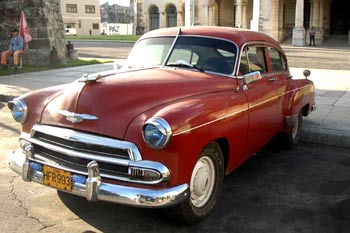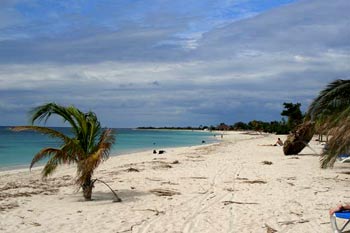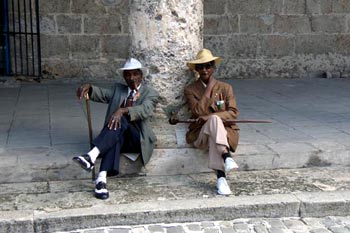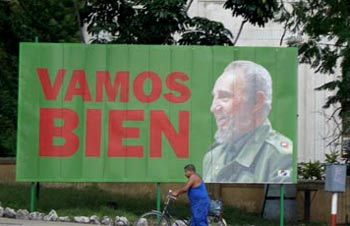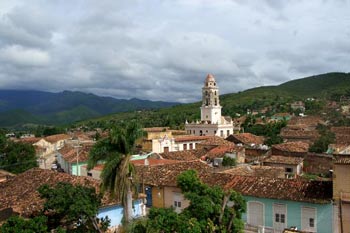|
|
As this edition of BELIZEmagazine.com goes online, 47 years ago today, on January 1, 1959, Fidel Castro assumed power in Cuba. It was the culmination of the six-year revolution that toppled the government of General Ruben Fulgencio Batista Zaldívar who, after formally resigning his position in Cuba's government and going through what historian Hugh Thomas describes as "a charade of handing over power" to his representatives, remaining family and closest associates, boarded a plane at 3 a.m. at Camp Colombia and flew to Ciudad Trujillo in the Dominican Republic. Batista left power early that morning as El Presiente Fidel Castro came to power, forever altering the course of geopolitical events in the hemisphere. Quoted below from the website HistoryofCuba.com, the history of Cuba is no doubt, colourful. As the website relays: |
"In an uprising known as the "Revolt of the Sergeants," Batista took over the Cuban government on September 4, 1933. The coup overthrew the liberal government of Gerardo Machado, and marked the beginning of the army's influence as an organized force in the running of the government. It also signaled Batista's emergence as self-appointed chief of the armed forces, king-maker and favored U.S. strong man." "U.S. Ambassador Benjamin Sumner Welles, sent to Cuba in April of 1933 to mediate differences between the government and opposing political groups, found an ally in Batista. "You're the only individual in Cuba today who represents authority," he said to the recently self-appointed Chief of the Military. When Batista asked what the U.S. "wanted done for recognition," Welles replied, "I will lay down no specific terms; the matter of your government is a Cuban matter and it is for you to decide what you will do about it." To Batista, this was an invitation to rule." "On January 14, 1934, Batista forced provisional president Ramón Grau San Martín to resign, and he appointed Carlos Mendieta to the presidency. Within five days, the U.S. recognized Cuba's new government." "For the next decade Batista ran the country from the
background, using puppet presidents [Carlos Mendieta (1934-35),
José A. Barnet (1935-36), Miguel Mariano Gómez
(1936) and Federuco Laredo Brú (1936-40)] and having
his way with the government, which continued a thirty-year tradition
of corruption." "Many of Batista's enemies faced the same fate as the ambitious Siegel. One of his most bitter opponents, Antonio Guiteras (founder of the student group Jóven Cuba) was gunned down by government forces in 1935 while waiting for a boat in Matanzas province. Others just seemed to disappear into thin air." "Batista's chance to sit on the president's chair came in 1940. Supported by a coalition of political parties, and by the Communists, he defeated his old rival Grau San Martín in the first presidential election under a new Cuban constitution. During his presidency, trade relations with the U.S. increased, and a series of war taxes were imposed on the Cuban population. In 1944, Grau San Martín was elected president and Batista was forced to relinquish control." "While living luxuriously in Daytona Beach, Florida, Batista ran for and won a seat in the Cuban Senate in 1948. Four years later he was running for president, but a poll published in the December, 1951 issue of the popular magazine "Bohemia" showed him in last place." "On March 10, 1952, almost twenty years after the Revolt of the Sergeants, Batista took over the government once more, this time against elected Cuban president Carlos Prío Socorras. The coup took place three months before the upcoming elections that he was sure to loose. Also running in that election (for a different office) was a young, energetic lawyer named Fidel Castro. On March 27 Batista's government was formally recognized by U.S. President Dwight D. Eisenhower." "Shortly after this recognition, Batista declared that, although he was completely loyal to Cuba's constitution of 1940, constitutional guarantees would have to be temporarily suspended, as well as the right to strike. In April, writes Hugh Thomas in THE CUBAN REVOLUTION, "Batista proclaimed a new constitutional code of 275 articles, claiming that the 'democratic and progressive essence' of the 1940 Constitution was preserved in the new law." "Batista opened the way for large-scale gambling in Havana, and he reorganized the Cuban state so that he and his political appointees could harvest the nation's riches. He announced that his government would match, dollar for dollar, any hotel investment over $1 million, which would include a casino license, and Lansky became the center of the entire Cuban gambling operation." "Under Batista, Cuba became profitable for American business and organized crime. Havana became the "Latin Las Vegas," a playground of choice for wealthy gamblers, and very little was said about democracy, or the rights of the average Cuban. Opposition was swiftly and violently crushed, and many began to fear the new government." "Just over a year after Batista's second coup, a small group of revolutionaries led by Fidel Castro attacked the Moncada Army Barracks in Santiago on July 26, 1953. The attack failed, and Batista sent General Martin Tamayo, the military commander of the district, a note ordering him to "kill ten rebels for every soldier killed" in the attack. This Presidential order was quickly dubbed the "ten-for-one" law. Tamayo carried out his order, murdering fifty-nine additional rebels (it would have taken 190 deaths to fulfill Batista's request)." "Having easily defeated the rebellion, and with Castro and most of the others in jail or dead, business was back to normal in Cuba. Mafia boss Meyer Lansky turned Havana into an international drug port, and Cuban officials continued to get rich even after a few years in government. Nightly, the "bagman" for Batista's wife collected 10 percent of the profits at Trafficante's casinos; the Sans Souci, and the casinos in the hotels Sevilla-Biltmore, Commodoro, Deauville and Capri. Batista's take from the Lansky casinos, the Hotel Nacional, the Montmartre Club and others, is said to be 30 percent. That was aside from his fair share of Cuba's general funds that should have been going to education, public health and city maintenance." "For a price, Batista handed contracts to dozens of U.S. corporations for massive construction projects, such as the Havana-Varadero highway, the Rancho Boyeros airport, train lines, the power company and a strange plan to dig a canal across Cuba." "Due to popular unrest, and to appease his U.S. friends, Batista held a mock election in which he was the only legal candidate. He won, becoming president of Cuba in 1954. Cubans, however, had learned not to trust him, and were demanding new, legitimate elections." "The distinguished Colonel Cosme de la Torriente, a surviving veteran of the Cuban War of Independence, emerged in late 1955 to offer compromise. A series of meetings led by de la Torriente became known as "El Diálago Cívico" (the civic dialogue). Writes Hugh Thomas: "This Diálago Cívico represented what turned out to be the last hope for Cuban middle-class democracy, but Batista was far too strong and entrenched in his position to make any concessions." "Batista was so confident of his power that on May 15, 1955, he released Castro and the remaining survivors of the Moncada attack, hoping to dissuade some of his critics. Within weeks it was rumored that Batista's military police was looking to kill Castro, so the rebel went to Mexico to plan the revolution." "The Havana Post, expressing the attitude of the U.S. business community after a survey of the four years of Batista's second reign, alluded to the disappearance of gangsterism and said: 'All in all, the Batista regime has much to commend it." Hugh Thomas disagrees with that commentary. "In a way," Thomas writes, "Batista's golpe formalized gangsterism: the machine gun in the big car became the symbol not only of settling scores but of an approaching change of government." "By late 1955 student riots and anti-Batista demonstration
had become frequent. These were dealt with in the violent manner
his military police had come to represent. Students attempting
to march from the University of Havana were stopped and beaten
by the police, and student leader José A. Echeverría
had to be hospitalized. Another popular student leader was killed
on December 10, leading to a funeral that became a gigantic
political protest with a 5-minute nationwide work stoppage." "In March of 1956 Batista refused to consider a proposal calling for elections by the end of the year. He was confident that he could defeat any revolutionary attempt from the many factions who opposed him." "Batista continued to rule with his usually confident
iron fist, even after the landing of the Granma in December
of 1956 (which brought the Castro brothers back to Cuba along
with Che Guevara and marked the beginning of the armed conflict).
"Batista's police also tracked down and killed Frank País, a coordinator with the 26th of July Movement, inciting a spontaneous strike in the three easternmost provinces of Cuba." "That same year, in midst of the revolutionary upheaval, the 21-story, 383-room Hotel Riviera was built in Havana at a cost of $14 million, most of which came from the Cuban government. It was Lansky's dream and crowing achievement. The hotel opened on December 10, with a floor show headlined by Ginger Rogers. Lansky's official title was "kitchen director," but he controlled every aspect of the hotel. He complained that Rogers "can wiggle her ass, but she can't sing a goddam note!" "But the seeds of the revolution had already sprouted a stronger, determined movement that would not allow the future of the Cuban nation to remain in the hands of gangsters and corrupt politicians. " "Another fake election in 1958 placed one last Batista puppet in the president's chair, but loosing the support of the U.S. government meant his days in power were numbered." "On January 1, 1959, after formally resigning his position in Cuba's government and going through what historian Hugh Thomas describes as "a charade of handing over power" to his representatives, remaining family and closest associates boarded a plane at 3 a.m. at Camp Colombia and flew to Ciudad Trujillo in the Dominican Republic. " "Throughout the night various flights out of Camp Colombia
took Batista's friends and high officials to Miami, New York,
New Orleans and Jacksonville. Batista's brother "Panchín,"
governor of Havana, left several hours later, and Meyer Lansky,
suffering from ill health, also flew out that night. There was
no provision made for the thousands of other Cubans who had
worked with Batista's regime. On January 3, 1959 at the Cospedes Park in Santiago de Cuba, Fidel Castro gace the following speech: "People of Santiago, Compatriots of All Cuba, we have finally reached Santiago de Cuba. The road was long and difficult, but we finally arrived. It was rumored that they expected us in the capital of the Republic at 2 p.m. today. No one was more amazed by this than I, because I was the first one to be surprised by this treacherous blow, which would place me in the capital of the Republic this morning. Moreover, I intended to be in the capital of the Republic — that is, in the new capital of the Republic — because Santiago de Cuba, in accordance with the wishes of the Provisional President, in accordance with the wishes of the Rebel Army, and in accordance with the wishes of the people of Santiago de Cuba, who really deserved it, Santiago will be the new capital of Cuba." "This measure may surprise some people. Admittedly, it is new, but the revolution is characterized precisely by its newness, by the fact that it will do things that have never been done before." "In making Santiago de Cuba the provisional capital of the Republic, we are fully aware of our reason for doing so. This is no attempt to cajole a specific area by demogogic means. It is simply that Santiago de Cuba has been the strongest bulwark of the revolution, a revolution that is beginning now. Our Revolution will be no easy task, but a harsh and dangerous undertaking, particularly in the initial phases. And in what better place could we establish the Government of the Republic than in this fortress of the Revolution. " "So that you may know that this will be a government solidly supported by the people of this heroic city, located in the foothills of the Sierra Maestra — because Santiago de Cuba is a part of the Sierra Maestra — Santiago de Cuba and the Sierra Maestra will provide the two strongest fortresses for the Revolution. However, there are other reasons that motivate us, and one is the military revolutionary movement, the truly military revolutionary movement which did not take place in [Camp] Colombia. " Fidel Castro made the 600-mile trip to Havana in an open jeep. He arrived in Havana on January 8, 1959 to a grateful Havana which was a riot of color and noise. In his first major address he called on the revolutionaries to disarm referring specifically to the students who led "the Revolutionary Directorate - who had broken into the barracks and removed a large number of rifles and a store of ammunition that belonged their. "As soon as possible I shall take the rifles off the streets." No one had the right to organize private armies. "Arms for what?" |
||||||||||||||||||||||




